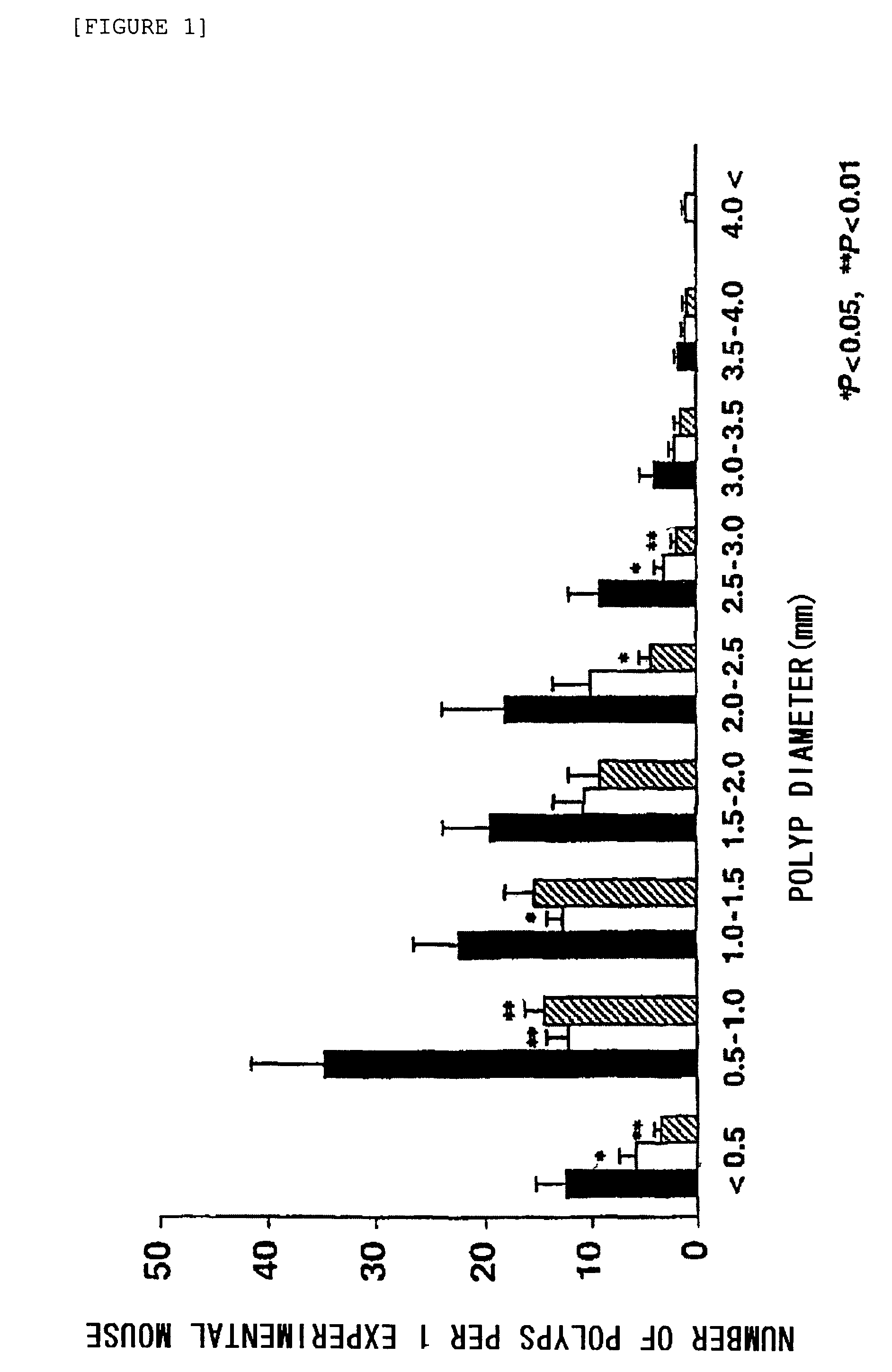Method of inhibiting intestinal polyps
a technology of intestinal polyps and suppressors, which is applied in the direction of biocide, drug compositions, active ingredients of phosphorous compounds, etc., can solve the problems of malignant transformation, inability to generally be called a completely satisfactory treatment, and time-consuming and burdensome colonoscopy for patients, so as to inhibit the development of intestinal polyps, inhibit the progress of existing intestinal polyps, and prevent the occurrence of intestinal polyps
- Summary
- Abstract
- Description
- Claims
- Application Information
AI Technical Summary
Benefits of technology
Problems solved by technology
Method used
Image
Examples
example 1
(1) Preparation of Tablets
[0037]Tablets (1000 tablets) each containing 250 mg of the active component compound 4-diethoxyphosphinoylmethyl-N-(4-bromo-2-cyanophenyl)benzamide (hereunder “Compound A”) were prepared according to the following formulation.
[0038]
ComponentAmount (g)Compound A250Lactose (per Japanese Pharmacopoeia)33.3Corn starch (per Japanese Pharmacopoeia)16.4Carboxymethyl cellulose calcium (per Japanese12.8Pharmacopoeia)Methyl cellulose (per Japanese Pharmacopoeia)6.0Magnesium stearate (per Japanese Pharmacopoeia)1.5Total320
[0039]The Compound A, lactose, corn starch and carboxymethyl cellulose calcium were thoroughly mixed according to this formulation, and the mixture was granulated with an aqueous methyl cellulose solution, passed through a #24 mesh, mixed with magnesium stearate and pressed into tablets.
(2) Preparation of Capsules
[0040]Hard gelatin capsules (1000 capsules) each containing 250 mg of Compound A were prepared according to the following formulation.
[0041...
example 2
[0047]The intestinal polyp-suppressing effects of the active component compound of the present invention were investigated as follows.
(1) Experimental Animals
[0048]The experimental animals were male Min mice of a familial adenomatous polyposis model (Apc (Adenomatous polyposis coli) gene deficient mice, C57BL / 6-ApcMin / +, Jackson Laboratory, Bar Harbor, Me.). These mice were purchased at age 5 weeks, and acclimatized for 2 weeks to laboratory conditions (24±2° C., humidity 55%, 12 hours light / 12 hours dark cycle, free access to feed and water) before being used in the tests. The feed was “AIN-76A” basic feed (Clea Japan).
[0049]Wild-type C54BL6J mice (from the same source) were subjected to the same test as a control.
(2) Experimental Medicine
[0050]Compound A was used as the experimental medicine. The compound was mixed to a specific concentration (400 ppm or 800 ppm) with the AIN-76A basic feed for use in the tests.
[0051]Feed comprising a specific amount of the...
PUM
| Property | Measurement | Unit |
|---|---|---|
| size | aaaaa | aaaaa |
| body weight | aaaaa | aaaaa |
| humidity | aaaaa | aaaaa |
Abstract
Description
Claims
Application Information
 Login to View More
Login to View More - R&D
- Intellectual Property
- Life Sciences
- Materials
- Tech Scout
- Unparalleled Data Quality
- Higher Quality Content
- 60% Fewer Hallucinations
Browse by: Latest US Patents, China's latest patents, Technical Efficacy Thesaurus, Application Domain, Technology Topic, Popular Technical Reports.
© 2025 PatSnap. All rights reserved.Legal|Privacy policy|Modern Slavery Act Transparency Statement|Sitemap|About US| Contact US: help@patsnap.com



